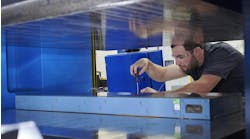USP filter series (USP 20, 41, 81, 161, and 320) is a stationary filter unit with plate exchanger that features a gear pump driven by an electric motor. Pump volume ranges from 22.7 to 284 lpm. Motor power ranges from 0.37 to 5.5 kW. Filtration levels are 4, 5, 7, or 10 m(c). The filter unit can be changed easily without tools and is fitted with a safety valve with pressure to 6 bar.
Internormen Technology Inc., (740) 452-7775, www.internormen.com



